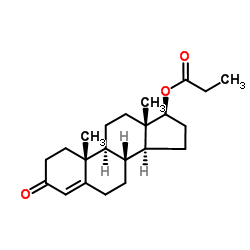Testosterone propionate

Testosterone propionate structure
|
Common Name | Testosterone propionate | ||
|---|---|---|---|---|
| CAS Number | 57-85-2 | Molecular Weight | 344.488 | |
| Density | 1.1±0.1 g/cm3 | Boiling Point | 454.6±45.0 °C at 760 mmHg | |
| Molecular Formula | C22H32O3 | Melting Point | 118-123 °C | |
| MSDS | Chinese USA | Flash Point | 196.3±28.8 °C | |
| Symbol |


GHS07, GHS08 |
Signal Word | Danger | |
|
Disrupting SUMOylation enhances transcriptional function and ameliorates polyglutamine androgen receptor-mediated disease.
J. Clin. Invest. 125(2) , 831-45, (2015) Expansion of the polyglutamine (polyQ) tract within the androgen receptor (AR) causes neuromuscular degeneration in individuals with spinobulbar muscular atrophy (SBMA). PolyQ AR has diminished transcriptional function and exhibits ligand-dependent proteotoxi... |
|
|
Supplementation with Pfaffia glomerata (Sprengel) Pedersen does not affect androgenic-anabolic parameters in male rats.
J. Ethnopharmacol. 161 , 46-52, (2015) Paffia spp (Amaranthacea) has a widespread use of in Brazil as a possible hormonal supplement and a substitute of Panax ginseng, although information on its reproductive effects is missing.To evaluated possible anabolic-androgenic or anti-androgenic effects o... |
|
|
Flaxseed suppressed prostatic epithelial proliferation in a rat model of benign prostatic hyperplasia.
J. Toxicol. Environ. Health A 78(7) , 453-65, (2015) Benign prostatic hyperplasia (BPH), a disease occurring frequently among elderly males, is a slow progressive enlargement of the fibromuscular and epithelial structures of the prostate gland. Dietary factors may influence the prostate and exert an influence o... |
|
|
Ultra high performance liquid chromatography/tandem mass spectrometry based identification of steroid esters in serum and plasma: an efficient strategy to detect natural steroids abuse in breeding and racing animals.
J. Chromatogr. A. 1284 , 126-40, (2013) During last decades, the use of natural steroids in racing and food producing animals for doping purposes has been flourishing. The endogenous or exogenous origin of these naturally occurring steroids has since remained a challenge for the different anti-dopi... |
|
|
Prenatal testosterone excess decreases neurokinin 3 receptor immunoreactivity within the arcuate nucleus KNDy cell population.
J. Neuroendocrinol. 27(2) , 100-10, (2015) Prenatal exposure of the female ovine foetus to excess testosterone leads to neuroendocrine disruptions in adulthood, as demonstrated by defects in responsiveness with respect to the ability of gonadal steroids to regulate gonadotrophin-releasing hormone (GnR... |
|
|
Sex steroid blockade enhances thymopoiesis by modulating Notch signaling.
J. Exp. Med. 211(12) , 2341-9, (2014) Paradoxical to its importance for generating a diverse T cell repertoire, thymic function progressively declines throughout life. This process has been at least partially attributed to the effects of sex steroids, and their removal promotes enhanced thymopoie... |
|
|
The role of AMP-activated protein kinase in the androgenic potentiation of cannabinoid-induced changes in energy homeostasis.
Am. J. Physiol. Endocrinol. Metab. 308(6) , E482-95, (2015) Orexigenic mediators can impact the hypothalamic feeding circuitry via the activation of AMP-dependent protein kinase (AMPK). Given that testosterone is an orexigenic hormone, we hypothesized that androgenic changes in energy balance are due to enhanced canna... |
|
|
The effects of perinatal testosterone exposure on the DNA methylome of the mouse brain are late-emerging.
Biol. Sex. Differ. 5 , 8, (2014) The biological basis for sex differences in brain function and disease susceptibility is poorly understood. Examining the role of gonadal hormones in brain sexual differentiation may provide important information about sex differences in neural health and dev... |
|
|
Transcriptomic analysis of hepatic responses to testosterone deficiency in miniature pigs fed a high-cholesterol diet.
BMC Genomics 16 , 59, (2015) Recent studies have indicated that low serum testosterone levels are associated with increased risk of developing hepatic steatosis; however, the mechanisms mediating this phenomenon have not been fully elucidated. To gain insight into the role of testosteron... |
|
|
Testosterone treatment is a potent tumor promoter for the rat prostate.
Endocrinology 155(12) , 4629-33, (2014) Testosterone is increasingly prescribed to middle aged and older men, but the safety of this treatment has been called into question, and the possible risk of prostate cancer is unknown. We treated Wistar Cpb: WU rats chronically via slow-release Silastic imp... |